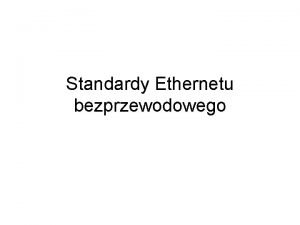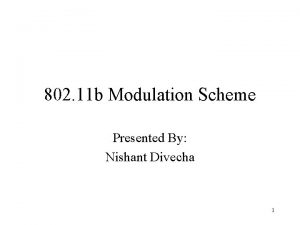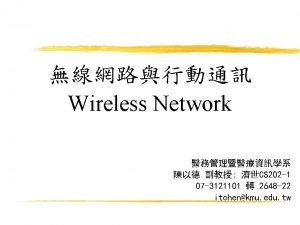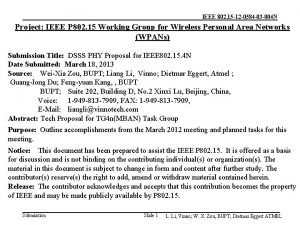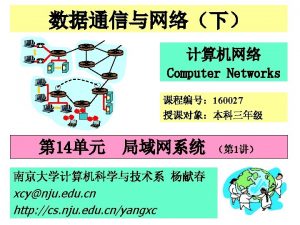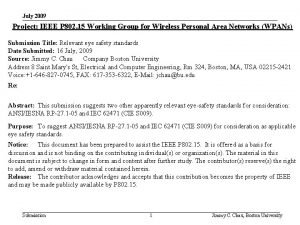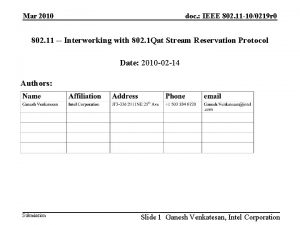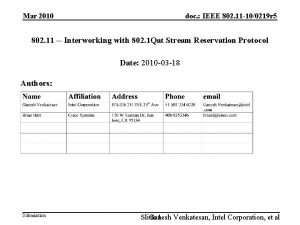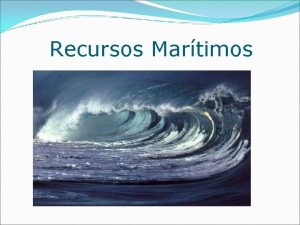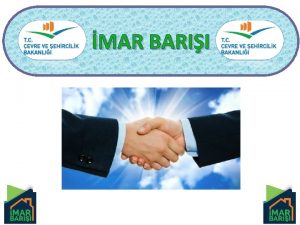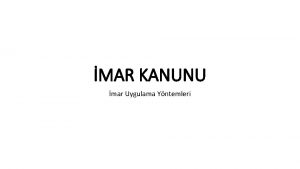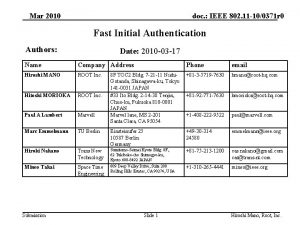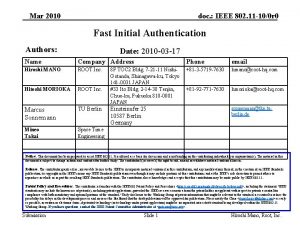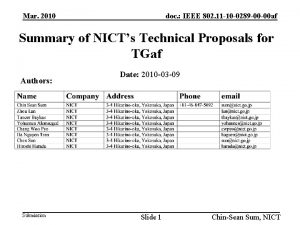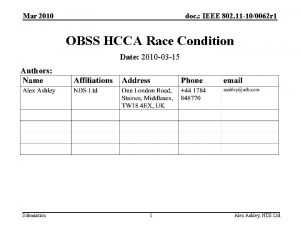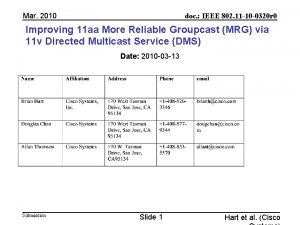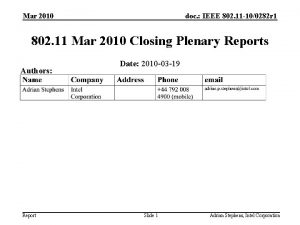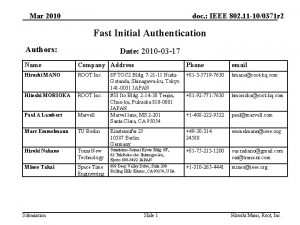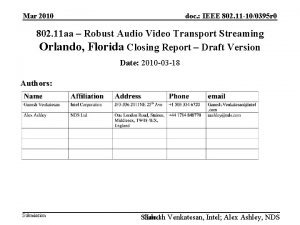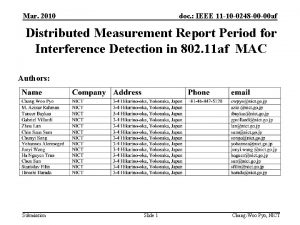Mar 2010 doc IEEE 802 11 100219 r


















- Slides: 18

Mar 2010 doc. : IEEE 802. 11 -10/0219 r 4 802. 11 -- Interworking with 802. 1 Qat Stream Reservation Protocol Date: 2010 -03 -18 Authors: Submission Ganesh Venkatesan, Intel Corporation, et al Slide 1

Mar 2010 doc. : IEEE 802. 11 -10/0219 r 4 Abstract This submission is an overview of proposed input from 802. 11 to 802. 1 Qat Annex-Q Clause Q. 3 -Discussions on the normative text (10/137 r 0) corresponding to 09/926 r 7 spawned interest in revisiting the solution proposed and seek a ‘future proof’ alternative, if possible. Note: In the rest of this presentation AP and non-AP STA denote 802. 11 implementations with dot 1 Qat. Networking set to true. Submission Slide Ganesh 2 Venkatesan, Intel Corporation, et al

Mar 2010 doc. : IEEE 802. 11 -10/0219 r 4 Handling SRP Reservation Requests Submission Ganesh Venkatesan, Intel Corporation, et al Slide 3

Mar 2010 doc. : IEEE 802. 11 -10/0219 r 4 Common Scenarios Listener(s) Talker DMN AP AP non-AP STA Alternate Data Path Talker Submission Listener(s) Talker Listener(s) Ganesh Venkatesan, Intel Corporation, et al Slide 4

Mar 2010 doc. : IEEE 802. 11 -10/0219 r 4 Advanced Scenario: STA is an Intermediate node or a Talker/Listener(s) • • DMN non-AP STA are intermediate nodes, Talker or Listener Note: This scenario is included for completeness. Support for this requires resolution of the “Station Bridge issue*”. AP non-AP STA Talker non-AP STA Listener(s) * See http: //www. ieee 802. org/1/files/public/docs 2008/avb-nfinn-802 -11 -bridging-0308 -v 3. pdf Submission Ganesh Venkatesan, Intel Corporation, et al Slide 5

Mar 2010 doc. : IEEE 802. 11 -10/0219 r 4 MSPRDU Processing at the AP/DMN (adopted proposal – 10/137 r 0) • • • A non-AP STA can either be Talker/Listener or an intermediate node in the path from the Talker to the Listener. An intermediate node non-AP STA or a non-AP STA that is also the Talker/Listener just pass the MSRPDU to the AP AP forwards the MSRPDU to the AP’s DMN invokes (DMN/AP interface) Reserve. request or Query. request with parameters corresponding to the received SRP Reservation/Query request If the MSRPDU is a Reservation Request and the AP has sufficient resources: • AP’s SME issues a MLME. ADDTS. response to the talker • AP’s SME issues a MLME. ADDTS. response to the listener AP responds to the DMN with a Reserve. confirm or Query. confirm Submission Ganesh Venkatesan, Intel Corporation, et al Slide 6

Mar 2010 doc. : IEEE 802. 11 -10/0219 r 4 MSRP Handling at AP/DMN (to Talker/Listener) In 10/137 r 0 Submission Ganesh Venkatesan, Intel Corporation, et al Slide 7

Mar 2010 doc. : IEEE 802. 11 -10/0219 r 4 Table Q. 3 SRP to 802. 11 SME Qo. S Services Mapping MSRP Attribute MAD Primitive 802. 11 SME Qo. S Service Description Talker Advertise MAD_Join_Request (new) SME. QUERY Query bandwidth availability without reservation Listener Ready or Listener Ready Failed MAD_Join_Request (new) SME. ADDTS Reserve bandwidth for a stream Listener Ready or Listener Ready Failed MAD_Join_Request () SME. ADDTS Modify bandwidth reserved for a stream – no renewal needed, if requirements have not changed. Listener Request Removed MAD_Leave_Request () SME. DELTS Free bandwidth associated with a stream MAD – MRP (Multiple Registration Protocol) Attribute Declaration Submission Ganesh Venkatesan, Intel Corporation, et al Slide 8

Mar 2010 doc. : IEEE 802. 11 -10/0219 r 4 Changes to 802. 11 – Summary 1. Ability for APs to send Autonomous ADDTS Response 2. Add ADDTS Response. indication to the STA MLME interface (omission in 10/137 r 0) 3. To the DMN 802. 11 interface (out of scope for 802. 11) • • Add SME-QUERY. {request|confirm} Add SME-ADDTS. {request|confirm} 802. 1 Qat 1. 2. 3. 4. Mandate that 802. 11 STAs and APs supporting SRP shall also support EDCA Admission Control The 802. 11 AP and SRP DMN shall co-exist in the same device The SRP DMN shall generate 802. 11 TSPECs as described in document 09/926 r 7 Mandate that 802. 11 STAs and APs supporting SRP shall encapsulate and de-encapsulate the 802. 1 q Tag Submission Ganesh Venkatesan, Intel Corporation, et al Slide 9

Mar 2010 doc. : IEEE 802. 11 -10/0219 r 4 Summary of discussions in LA • Need a discussion on the internals of 802. 1 Qat as far as SRP goes – • • Scheduled for the joint meeting with 802. 1 AVB in March, 2010 How does the current proposal (10/137 r 0) deal with Power Save? How does the current proposal deal with TSPEC, TCLAS and TCLAS processing negotiation? Would the current proposal be able to take advantage of enhancements in 802. 11? Should the solution be the same irrespective of if the 802. 11 STA is a Talker/Listener or is just a node in the path from the Talker to the Listener? Submission Slide Ganesh 10 Venkatesan, Intel Corporation, et al

Mar 2010 doc. : IEEE 802. 11 -10/0219 r 4 Alternate Proposal-A. 1 -- MSRP Handling at AP/DMN (to Talker/Listener) • • non-AP STA at the Talker/Listener ends parse SRP and invoke corresponding 802. 11 mechanisms Synchronization issues need to be addressed at the AP Submission Ganesh Slide 11 Venkatesan, Intel Corporation, et al

Mar 2010 doc. : IEEE 802. 11 -10/0219 r 4 Alternate Proposal-A. 2 -- MSRP Handling at AP/DMN (to Talker/Listener) • • Upper layer request for a. 1 Qat reservation is mapped by. 1 Qat Talker/Listener to a. 11 ADDTS exchange, and if successful, the. 1 Qat Talker/Listener proceeds with MSRPDU exchanges No Synchronization issues at the AP Submission • • Network-side request for a. 1 Qat reservation is processed by DMN at AP (omitting. 11 reservations) and passed to. 1 Qat Talker/Listener which requests the SME to complete a. 11 ADDTS exchange. The. 1 Qat Talker/Listener reports the outcome to the DMN at AP No Synchronization issues at the AP Ganesh Slide 12 Venkatesan, Intel Corporation, et al

Mar 2010 doc. : IEEE 802. 11 -10/0219 r 4 What is in the Reserve Request? 1. TSPEC Element with parameters set to values derived from information in the MSRPDU 2. Optionally TCLAS and TCLAS Processing elements. Submission Ganesh Slide 13 Venkatesan, Intel Corporation, et al

Mar 2010 doc. : IEEE 802. 11 -10/0219 r 4 The TSPEC Element in Reserve Request Element ID Length TS Info Nominal MSDU Size Max MSDU Size Min Service Interval Max Service Interval Inactivity Interval Suspension Interval SRP Tspec Max. Fram e. Size + 18 SRP Tspec Max. Fra me. Size + 18 n/a n/a 10 10 ? ? 2 EDCAAC 13 55 09/926 r 7 Slide #20 HCCA 13 55 09/925 r 7 Slide #22 1 1 3 2 Service Start Time Minimum Data Rate Mean Data Rate Peak Data Rate Burst Size EDCAAC n/a n/a HCCA n/a 0 (SRP Tspec Max. Fram e. Size +18) * SRP Tspec Max. Interv al. Frames (SRP Tspec Max. Fram e. Size + 18) * SRP Tspec Max. Interv al. Frames (SRP Tspec Max. Fra me. Size + 18) * SRP Tspec Max. Inte rval. Fra mes * 10 -2 4 4 Octets Submission 4 4 4 Delay Bound Minimum PHY Rate Surplus Bandwidth Allowance Medium Time 20 msecs 11. 42857 *(SRP TSpec Max. Fram e. Size + 18) * SRP TSpec Max. Interv al. Frames bits/sec 1. 2 n/a 4 4 4 n/a 2 2 Ganesh Slide 14 Venkatesan, Intel Corporation, et al

Mar 2010 doc. : IEEE 802. 11 -10/0219 r 4 What is in the Reserve Response? A Status Code corresponding to the Success/Failure of TSPEC/TCLAS negotiation between the AP and the STA Submission Ganesh Slide 15 Venkatesan, Intel Corporation, et al

Mar 2010 doc. : IEEE 802. 11 -10/0219 r 4 Reserve Request/ADDTS Request synchronization How to preserve the identity of the messages in the transaction: Reserve Request, [ADDTS Request, ADDTS Response]+, Reserve Response? 802. 11 Dialog Token will not work here. • The ADDTS Request from the STA cannot be uniquely identified as the response to the Reserve Request from the AP Submission Ganesh Slide 16 Venkatesan, Intel Corporation, et al

Mar 2010 doc. : IEEE 802. 11 -10/0219 r 4 A solution to the problem in the previous slide 1. Reserve Response contains a TSPEC element (instead of the description in Slide-15) 2. Since Reserve Request and Reserve Response are essentially ADDTS Request and ADDTS Response frames, should we just call them that? 3. The difference is that now the AP issues ADDTS Request and the STA response with ADDTS Response Submission Ganesh Slide 17 Venkatesan, Intel Corporation, et al

Mar 2010 doc. : IEEE 802. 11 -10/0219 r 4 Straw Polls 1. Should we stay with just the current solution (Slide-7)? 2. Which of the three alternate proposals do you prefer • Slide-11 • Slide-12 • Slide-13 3. Should we allow a simple and a complete solution – current solution (slide-7) + Alternate (one of slide-11, 12 or 13) or just an Alternate Proposal (one of slide-11, 12 or 13)? 4. If we choose the solution in slide-13 (or 17) 1. Should the new frames be called Reserve. Request and Reserve. Response? 2. Should the new frames be called ADDTS. Request and ADDTS. Response (and appropriate semantics added)? Submission Ganesh Slide 18 Venkatesan, Intel Corporation, et al











